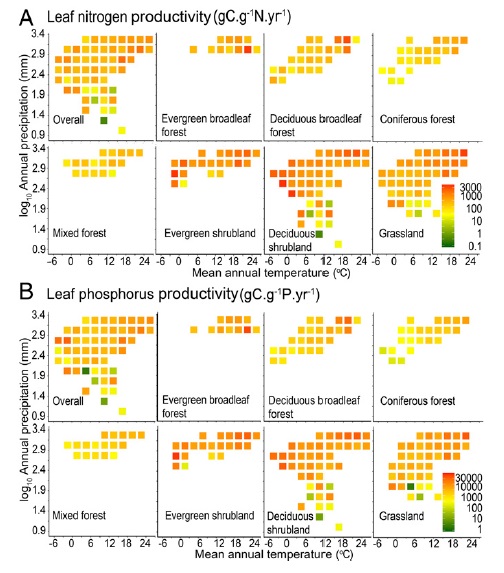Chinese scientists have identified the patterns of plant carbon, nitrogen, and phosphorus concentration in relation to productivity. The results were published entitled “Patterns of plant carbon, nitrogen, and phosphorus concentration in relation to productivity in China’s terrestrial ecosystems” in Proceedings of the National Academy of Sciences of the United States of America in April 18.
Plant nitrogen (N) and phosphorus (P) concentrations regulate productivity and carbon (C) sequestration in terrestrial ecosystems. Estimates of the allocation of N and P content in plant tissues and quantification of the relationship between these nutrient content and photosynthetic capacity are of fundamental importance to predict ecosystem C sequestration under future global change.
This study has evaluated large-scale patterns of community-level N and P concentrations in different plant tissues including leaves, stems and roots and examined how nutrient allocations are coupled with plant productivity in China’s terrestrial biomes.
The results have shown that nutrient concentrations in leaves are less responsive to abiotic environments than those in woody stems and roots (stable leaf nutrient concentration hypothesis). The relationships between leaf nutrient contents and vegetation primary productivity are stronger when less nutrients are allocated to the woody tissues (productivity–nutrient allocation hypothesis) and are stronger in deciduous than in evergreen vegetation (productivity–leaf lifespan hypothesis).
These findings not only provide key parameters to develop empirical models to scale the responses of plants to global change from a single tissue to the whole community but also offer large-scale evidence of biome-dependent regulation of C sequestration by nutrients. These results suggest that by increasing leaf N and P productivity, global warming may enhance gross primary production in China’s terrestrial ecosystems.
Dr. TANG Zhiyao from Peking University, Dr. XU Wenting from Institute of Botany, CAS, and Dr. ZHOU Guoyi from South China Botanical Garden, CAS served as co-first authors. Prof. FANG Jingyun and Prof. XIE Zongqiang from Institute of Botany, CAS were the corresponding authors.
This work was supported by funds from the Strategic Priority Research Program of the Chinese Academy of Sciences and the National Natural Science Foundation of China.

Relationship of leaf N (A) and P (B) productivity to mean annual
temperature and log-transformed precipitation in China’s terrestrial biomes.
CONTACT INFO
Prof. Jingyun Fang or Prof. Zongqiang Xie
State Key Laboratory of Vegetation and Environmental Change
Institute of Botany, Chinese Academy of Sciences,
20 Nanxincun, Xiangshan, Beijing 100093, China
E-mail: fangjingyun@ibcas.ac.cn
or xie@ibcas.ac.cn
Chinese scientists have identified the patterns of plant carbon, nitrogen, and phosphorus concentration in relation to productivity. The results were published entitled “Patterns of plant carbon, nitrogen, and phosphorus concentration in relation to productivity in China’s terrestrial ecosystems” in Proceedings of the National Academy of Sciences of the United States of America in April 18.
Plant nitrogen (N) and phosphorus (P) concentrations regulate productivity and carbon (C) sequestration in terrestrial ecosystems. Estimates of the allocation of N and P content in plant tissues and quantification of the relationship between these nutrient content and photosynthetic capacity are of fundamental importance to predict ecosystem C sequestration under future global change.
This study has evaluated large-scale patterns of community-level N and P concentrations in different plant tissues including leaves, stems and roots and examined how nutrient allocations are coupled with plant productivity in China’s terrestrial biomes.
The results have shown that nutrient concentrations in leaves are less responsive to abiotic environments than those in woody stems and roots (stable leaf nutrient concentration hypothesis). The relationships between leaf nutrient contents and vegetation primary productivity are stronger when less nutrients are allocated to the woody tissues (productivity–nutrient allocation hypothesis) and are stronger in deciduous than in evergreen vegetation (productivity–leaf lifespan hypothesis).
These findings not only provide key parameters to develop empirical models to scale the responses of plants to global change from a single tissue to the whole community but also offer large-scale evidence of biome-dependent regulation of C sequestration by nutrients. These results suggest that by increasing leaf N and P productivity, global warming may enhance gross primary production in China’s terrestrial ecosystems.
Dr. TANG Zhiyao from Peking University, Dr. XU Wenting from Institute of Botany, CAS, and Dr. ZHOU Guoyi from South China Botanical Garden, CAS served as co-first authors. Prof. FANG Jingyun and Prof. XIE Zongqiang from Institute of Botany, CAS were the corresponding authors.
This work was supported by funds from the Strategic Priority Research Program of the Chinese Academy of Sciences and the National Natural Science Foundation of China.

Relationship of leaf N (A) and P (B) productivity to mean annual
temperature and log-transformed precipitation in China’s terrestrial biomes.
CONTACT INFO
Prof. Jingyun Fang or Prof. Zongqiang Xie
State Key Laboratory of Vegetation and Environmental Change
Institute of Botany, Chinese Academy of Sciences,
20 Nanxincun, Xiangshan, Beijing 100093, China
E-mail: fangjingyun@ibcas.ac.cn
or xie@ibcas.ac.cn
